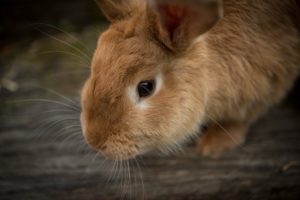Every-Bunny Watch Out For GI Stasis

If you have a pet rabbit, you know how much they love to eat. The quality of a rabbit’s diet plays a huge role in its health, and an improper diet can lead to potentially serious diseases, including gastrointestinal (GI) stasis.
Dr. J. Jill Heatley, an associate professor at the Texas A&M College of Veterinary Medicine & Biomedical Sciences, has advice for avoiding this disease and keeping your rabbit healthy.
GI stasis occurs when the stomach and intestines slow down, or stop completely, in the digestive process.
“Rabbits are vegetarians, herbivores, and lovers of fiber,” Heatley said. “As such, their gastrointestinal tract should always be moving.”
She said GI stasis can be caused by many things but is often from a lack of fiber, bad teeth, insufficient exercise, toxins, or even some antibiotics. It could also be a result of bad bacteria colonizing the gastrointestinal tract and causing gas, pain, and fever.
Since GI stasis has many possible causes, rabbit owners should always watch out for any symptoms of the disease.
Heatley said rabbits with GI stasis may feel a lot of gut pain, which would cause a hunched posture. They may also be less active, eat less, or have small, dark droppings. Some may even drool because of teeth or nose problems.
If any symptoms of GI stasis are noticed, the rabbit should be taken to a veterinarian who has experience working with exotic pets as soon as possible.
Treatments for GI stasis include fluids to hydrate, medications to control pain, and special diets and probiotics to help the gastrointestinal tract return to normal function. The veterinarian may also do X-rays or other tests to rule out more serious causes of GI stasis, such as kidney or heart failure.
“With an early diagnosis and appropriate treatment, the likelihood of complete recovery is good,” Heatley said.
Luckily, there are many things rabbit owners can do to reduce the chance that GI stasis will occur.
“Providing a good diet of mainly fiber from hay and vegetables, avoiding sugary treats, providing plenty of fresh water, and offering only one tablespoon of pellets per pound of rabbit are good choices,” Heatley said.
She recommends making sure rabbits stay active and have access to fresh air and sunlight. Regular trips to the veterinarian can also help keep a rabbit’s teeth, feet, and diet in good condition.
GI stasis can have very serious health implications, but it can usually be avoided with careful monitoring and preventative steps. If you have a pet rabbit, make sure you are always watching out for any changes in behavior or other symptoms of this disease.
Pet Talk is a service of the College of Veterinary Medicine & Biomedical Sciences, Texas A&M University. Stories can be viewed on the web at vetmed.tamu.edu/news/pet-talk. Suggestions for future topics may be directed to editor@cvm.tamu.edu.


